The trash bag market stands at the threshold of a decade-long expansion trajectory that promises to reshape waste management solutions and disposal technology. The market's journey from USD 12.3 billion in 2025 to USD 19.7 billion by 2035 represents substantial growth, demonstrating the accelerating adoption of advanced waste containment technology and premium disposal optimization across residential, commercial, and industrial sectors.
The first half of the decade (2025-2030) will witness the market climbing from USD 12.3 billion to approximately USD 15.8 billion, adding USD 3.5 billion in value, which constitutes 47% of the total forecast growth period. This phase will be characterized by the rapid adoption of premium trash bag products, driven by increasing waste generation and the growing need for advanced disposal solutions worldwide. Enhanced puncture resistance capabilities and odor control systems will become standard expectations rather than premium options.
The latter half (2030-2035) will witness continued growth from USD 15.8 billion to USD 19.7 billion, representing an addition of USD 3.9 billion or 53% of the decade's expansion. This period will be defined by mass market penetration of specialized waste management technologies, integration with comprehensive disposal platforms, and seamless compatibility with existing waste infrastructure. The market trajectory signals fundamental shifts in how consumers and businesses approach waste containment quality and disposal management, with participants positioned to benefit from growing demand across multiple bag types and application segments.
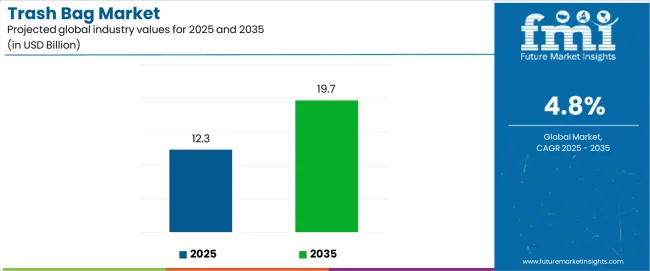
| Period | Primary Revenue Buckets | Share | Notes |
|---|---|---|---|
| Today | Drawstring bags (standard) | 38% | Residential use, kitchen applications |
| Flat seal bags | 24% | Commercial waste, office buildings | |
| Contractor bags (heavy-duty) | 22% | Construction sites, industrial use | |
| Specialty bags (scented/biodegradable) | 16% | Premium residential, eco-conscious consumers | |
| Future (3-5 yrs) | Smart waste bags with RFID | 28-34% | Waste tracking, smart city initiatives |
| Heavy-duty contractor bags | 26-32% | Construction boom, industrial growth | |
| Compostable certified bags | 18-24% | Environmental regulations, green building | |
| Odor-blocking premium bags | 12-18% | Urban living, apartment complexes | |
| Commercial flat seal bags | 8-14% | Office buildings, retail establishments |
| Metric | Value |
|---|---|
| Market Value (2025) | USD 12.3 billion |
| Market Forecast (2035) | USD 19.7 billion |
| Growth Rate | 4.8% CAGR |
| Leading Technology | Drawstring Trash Bags |
| Primary Application | Residential Segment |
The market demonstrates strong fundamentals with drawstring trash bag systems capturing a dominant share through advanced closure capabilities and waste containment optimization. Residential applications drive primary demand, supported by increasing waste generation and premium bag equipment adoption requirements. Geographic expansion remains concentrated in developed markets with established waste management cultures, while emerging economies show accelerating adoption rates driven by urbanization and rising living standards.
Primary Classification: The market segments by bag type into drawstring bags, flat seal bags, contractor bags, and specialty bags, representing the evolution from basic waste collection materials to sophisticated disposal solutions for comprehensive waste containment optimization.
Secondary Classification: Capacity segmentation divides the market into small bags (4-8 gallons), medium bags (13-30 gallons), large bags (33-45 gallons), and extra-large bags (55+ gallons), reflecting distinct requirements for waste volume, disposal frequency, and carrying capacity standards.
Tertiary Classification: Application segmentation covers residential use, commercial offices, retail establishments, healthcare facilities, and industrial operations, while material composition spans high-density polyethylene (HDPE), low-density polyethylene (LDPE), and biodegradable polymer categories.
Regional Classification: Geographic distribution covers North America, Latin America, Western Europe, Eastern Europe, East Asia, South Asia Pacific, and Middle East & Africa, with developed markets leading adoption while emerging economies show accelerating growth patterns driven by urbanization and waste management modernization programs.
The segmentation structure reveals technology progression from standard waste collection materials toward sophisticated disposal systems with enhanced strength and odor control capabilities, while application diversity spans from residential operations to commercial establishments requiring precise containment solutions.
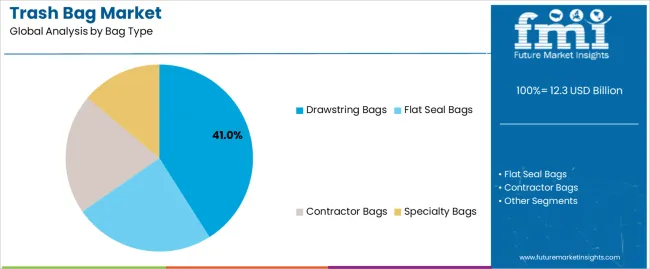
Market Position: Drawstring Bag systems command the leading position in the trash bag market with 41% market share through advanced closure features, including superior tie convenience, load-bearing capacity, and waste containment optimization that enable consumers to achieve optimal disposal efficiency across diverse residential and commercial environments.
Value Drivers: The segment benefits from consumer preference for convenient disposal systems that provide consistent closure performance, enhanced waste containment, and handling optimization without compromising bag integrity or affecting disposal convenience characteristics. Advanced polymer engineering enables easy closure, secure containment, and integration with existing waste systems, where closure performance and convenience consistency represent critical user requirements.
Competitive Advantages: Drawstring Bag systems differentiate through proven closure reliability, consistent load-bearing characteristics, and integration with automated waste collection systems that enhance disposal efficiency while maintaining optimal sanitation standards suitable for diverse residential and commercial applications.
Key market characteristics:
Flat Seal Bag systems maintain a 27% market position in the trash bag market due to their cost-effectiveness and commercial advantages. These systems appeal to businesses requiring efficient disposal operations with competitive pricing for diverse waste containment applications. Market growth is driven by operator preference, emphasizing operational efficiency and versatile containment through optimized bag design.
Contractor Bag systems capture 19% market share through heavy-duty requirements in construction sites, industrial facilities, and large-scale cleanup operations. These establishments demand robust containment systems capable of handling diverse debris while providing exceptional durability and puncture resistance.
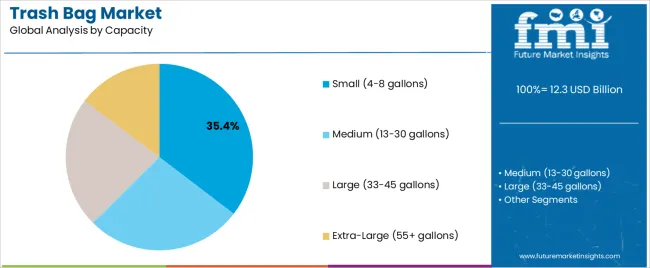
Market Context: Medium capacity bags (13-30 gallons) demonstrate 35.4% market share due to widespread adoption of household waste management and increasing focus on regular disposal, waste consolidation, and collection optimization that maximizes containment efficiency while maintaining structural standards.
Appeal Factors: Medium bag users prioritize containment capacity, structural integrity, and integration with diverse waste types that enables optimized disposal operations across multiple household sizes. The segment benefits from substantial residential investment and waste management programs that emphasize the acquisition of medium bags for disposal optimization and convenience applications.
Growth Drivers: Urbanization programs incorporate medium bags as standard containment for household waste, while residential growth increases demand for versatile capacity capabilities that comply with collection standards and minimize disposal complexity.
Market Challenges: Varying waste volumes and disposal composition may limit bag standardization across different households or commercial scenarios.
Application dynamics include:
Small capacity bag applications capture market share through individual room requirements in bathrooms, offices, and single-space applications. These applications demand compact containment systems capable of operating with residential equipment while providing effective waste collection and operational simplicity capabilities.
Large capacity bag applications account for market share, including industrial operations, construction sites, and high-volume disposal requiring substantial containment capabilities for operational optimization and collection efficiency.
Market Position: Residential applications command significant market position with 5.4% CAGR through growing household consumption trends and waste generation adoption for regular disposal management.
Value Drivers: This application segment provides the ideal combination of convenience and reliability, meeting requirements for daily disposal, odor control, and operational efficiency without reliance on commercial services.
Growth Characteristics: The segment benefits from broad applicability across household sizes, automated collection adoption, and established disposal programs that support widespread bag usage and operational convenience.
Market Context: Urban Households dominate the market with 5.7% CAGR, reflecting the primary demand source for trash bags in residential disposal and waste management applications.
Business Model Advantages: Urban applications provide direct market demand for reliable containment materials, driving quality standards and disposal innovation while maintaining sanitation and convenience requirements.
Operational Benefits: Residential applications include waste protection, odor assurance, and user experience enhancement that drive consistent demand for trash bags while providing access to latest containment technologies.
| Category | Factor | Impact | Why It Matters |
|---|---|---|---|
| Driver | Urbanization & population growth (increasing waste generation, apartment living) | ★★★★★ | Rapid urban expansion creates massive demand for waste containment; higher population density drives market expansion. |
| Driver | Commercial sector expansion & office building growth | ★★★★★ | Proliferation of commercial spaces globally; standardized waste management requirements across multiple locations drive bulk procurement and consistent demand. |
| Driver | Plastic bag regulations & waste management standards (government mandates) | ★★★★☆ | Environmental pressure driving premium bag adoption; regulations mandating stronger containment create demand for advanced products. |
| Restraint | Competition from reusable waste containers & alternative disposal methods | ★★★☆☆ | Growing adoption of permanent container programs in select markets; circular economy models create substitution pressure for disposable bags. |
| Restraint | Raw material cost volatility & polyethylene price fluctuations | ★★★★☆ | Petroleum-based material price variations impact profit margins; commodity nature of basic bags constrains pricing power during cost increases. |
| Trend | Smart waste management & IoT integration (RFID tags, waste tracking) | ★★★★★ | Technology integration enabling waste monitoring; smart city initiatives drive premium bag adoption for data collection. |
| Trend | Odor control & scent innovations (advanced barrier technology) | ★★★★☆ | Technical improvements enhancing user experience; antimicrobial treatments and scent technology replacing basic containment. |
The trash bag market demonstrates varied regional dynamics with Growth Leaders including China (6.7% growth rate) and India (7.2% growth rate) driving expansion through urbanization and waste management modernization initiatives. Steady Performers encompass United States (4.9% growth rate), Germany (5.1% growth rate), and developed regions, benefiting from established waste collection cultures and disposal system adoption. Emerging Markets feature Brazil (6.8% growth rate) and developing regions, where urban expansion and waste infrastructure development support consistent growth patterns.
Regional synthesis reveals North American markets leading value generation through premium product adoption and branded waste management culture, while Asian markets demonstrate highest volume growth supported by urbanization and rising waste generation trends. European markets show moderate growth driven by regulatory waste requirements and quality enhancement integration.
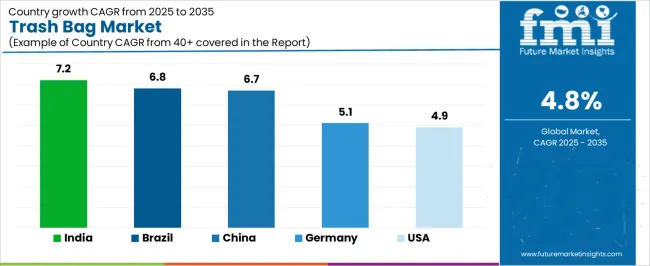
| Region/Country | 2025-2035 Growth | How to win | What to watch out |
|---|---|---|---|
| China | 6.7% | Urban waste scale; cost-effective solutions | Quality inconsistency; local competition |
| India | 7.2% | City expansion; affordable premium bags | Infrastructure gaps; distribution challenges |
| United States | 4.9% | Brand positioning; odor-control innovation | Market saturation; margin pressure |
| Germany | 5.1% | Compliance solutions; premium positioning | Regulatory complexity; cost sensitivities |
| Brazil | 6.8% | Urban growth; regional partnerships | Economic volatility; logistics constraints |
China establishes strong market growth through massive urbanization infrastructure and comprehensive waste management development, integrating advanced trash bags as standard components in residential complexes and commercial installations. The country's 6.7% growth rate reflects explosive urban population growth and domestic waste generation that mandates the use of quality containment systems in residential and commercial facilities. Growth concentrates in major urban centers, including Shanghai, Beijing, and Shenzhen, where apartment complexes showcase integrated waste systems that appeal to residents seeking advanced containment capabilities and disposal optimization applications.
Chinese manufacturers are developing domestically-produced bag solutions that combine local production advantages with functional operational features, including enhanced puncture resistance and odor control capabilities. Distribution channels through retail chains and property management partnerships expand market access, while urban living culture supports adoption across diverse residential and commercial segments.
Strategic Market Indicators:
In Mumbai, Delhi, and Bangalore, residential complexes and commercial buildings are implementing trash bags as standard waste management for sanitation and disposal applications, driven by increasing urban investment and waste infrastructure programs that emphasize the importance of containment quality. The market holds a 7.2% growth rate, supported by rapid urbanization and modernization programs that promote quality bag systems for residential and commercial applications. Indian consumers are adopting bag solutions that provide consistent structural performance and waste containment features, particularly appealing in urban regions where waste management and sanitation represent critical living standards.
Market expansion benefits from growing middle-class consumption patterns and urban development that enable widespread adoption of quality containment systems for residential and commercial applications. Technology adoption follows patterns established in consumer goods, where functionality and value drive procurement decisions and household deployment.
Market Intelligence Brief:
United States establishes market leadership through comprehensive residential programs and advanced waste management culture development, integrating trash bags across household and commercial applications. The country's 4.9% growth rate reflects established consumer consumption patterns and mature containment technology adoption that supports widespread use of premium bag systems in homes and commercial facilities. Growth concentrates in major metropolitan areas, including New York, Los Angeles, and Chicago, where residential culture showcases mature bag deployment that appeals to consumers seeking proven containment capabilities and convenience applications.
American households leverage established retail networks and comprehensive product availability, including scented bags and heavy-duty options that create user differentiation and operational advantages. The market benefits from mature waste collection infrastructure and consumer willingness to invest in quality containment materials that enhance disposal experience and convenience optimization.
Market Intelligence Brief:
Germany's advanced environmental regulation market demonstrates sophisticated trash bag deployment with documented compliance effectiveness in residential applications and commercial facilities through integration with existing waste systems and regulatory infrastructure. The country leverages waste separation legislation and containment standards to maintain a 5.1% growth rate. Urban centers, including Berlin, Munich, and Hamburg, showcase premium installations where trash bags integrate with comprehensive waste platforms and compliance systems to optimize containment operations and regulatory effectiveness.
German consumers prioritize waste compliance and environmental credentials in bag procurement, creating demand for certified products with advanced features, including biodegradable certifications and recycled content. The market benefits from established environmental consciousness and willingness to invest in premium containment materials that provide superior compliance benefits and adherence to regulatory standards.
Market Intelligence Brief:
Brazil's market expansion benefits from diverse urban demand, including residential growth in São Paulo and Rio de Janeiro, commercial establishment development, and rising waste generation that increasingly incorporate trash bag solutions for containment applications. The country maintains a 6.8% growth rate, driven by urbanization and increasing recognition of trash bag benefits, including improved waste management and enhanced sanitation.
Market dynamics focus on affordable quality bag solutions that balance containment performance with cost considerations important to Brazilian consumers. Growing urban development creates continued demand for modern waste systems in new residential infrastructure and commercial modernization projects.
Strategic Market Considerations:
The European trash bag market is projected to grow from USD 3.8 billion in 2025 to USD 5.9 billion by 2035, registering a CAGR of 4.5% over the forecast period. Germany is expected to maintain its leadership position with a 31.2% market share in 2025, supported by its strong waste management regulations and urban population density.
United Kingdom follows with a 23.8% share in 2025, driven by residential waste requirements and commercial building expansion. France holds a 19.6% share through established household culture and waste management applications. Italy commands a 14.1% share, while Spain accounts for 11.3% in 2025. The rest of Europe region is anticipated to gain momentum, expanding its collective share from 7.2% to 8.4% by 2035, attributed to increasing urban development in Nordic countries and emerging residential establishments implementing quality waste management programs.
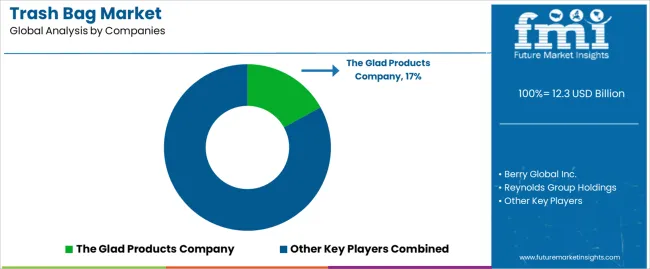
| Stakeholder | What they actually control | Typical strengths | Typical blind spots |
|---|---|---|---|
| Global manufacturers | Production capacity, supply chain, distribution networks | Scale efficiency, consistent quality, broad reach | Innovation speed; local customization |
| Specialty converters | Smart technology; odor-control innovation; premium designs | Quality leadership; consumer partnerships; differentiation | Mass market penetration; price competition |
| Regional producers | Local manufacturing, distribution channels, competitive pricing | Market proximity; cultural understanding; cost advantage | Technology gaps; international expansion |
| Private label suppliers | Retailer partnerships, value positioning, volume production | Price competitiveness; retail access; volume scale | Brand loyalty; premium segment access |
| Technology innovators | Smart features, IoT integration, material science | Technical expertise; patent portfolio; performance | Market scalability; distribution challenges |
| Item | Value |
|---|---|
| Quantitative Units | USD 12.3 billion |
| Bag Type | Drawstring Bags, Flat Seal Bags, Contractor Bags, Specialty Bags |
| Capacity | Small (4-8 gallons), Medium (13-30 gallons), Large (33-45 gallons), Extra-Large (55+ gallons) |
| Material Composition | High-Density Polyethylene (HDPE), Low-Density Polyethylene (LDPE), Biodegradable Polymers |
| Application | Residential Use, Commercial Offices, Retail Establishments, Healthcare Facilities, Industrial Operations |
| Regions Covered | North America, Latin America, Western Europe, Eastern Europe, East Asia, South Asia Pacific, Middle East & Africa |
| Countries Covered | United States, China, Germany, India, Brazil, United Kingdom, Canada, Japan, France, Mexico, and 30+ additional countries |
| Key Companies Profiled | The Glad Products Company, Berry Global Inc., Reynolds Group Holdings, Novolex Holdings Inc., Poly-America L.P., Inteplast Group, AEP Industries |
| Additional Attributes | Dollar sales by bag type and capacity categories, regional adoption trends across North America, East Asia, and Western Europe, competitive landscape with plastic manufacturers and waste management suppliers, consumer preferences for odor control and puncture resistance, integration with waste collection platforms and smart city systems, innovations in biodegradable technology and IoT enhancement, and development of smart bag solutions with enhanced tracking and waste management capabilities. |
The global trash bag market is estimated to be valued at USD 12.3 billion in 2025.
The market size for the trash bag market is projected to reach USD 19.7 billion by 2035.
The trash bag market is expected to grow at a 4.8% CAGR between 2025 and 2035.
The key product types in trash bag market are drawstring bags, flat seal bags, contractor bags and specialty bags.
In terms of capacity, small (4-8 gallons) segment to command 35.4% share in the trash bag market in 2025.






Full Research Suite comprises of:
Market outlook & trends analysis
Interviews & case studies
Strategic recommendations
Vendor profiles & capabilities analysis
5-year forecasts
8 regions and 60+ country-level data splits
Market segment data splits
12 months of continuous data updates
DELIVERED AS:
PDF EXCEL ONLINE
Trash Bag Industry Analysis in Europe Forecast Outlook 2025 to 2035
Trash Bag Market Leaders & Competitive Insights
Türkiye Trash Bag Market Trends & Growth Forecast 2024-2034
Scented Trash Bags Market Size and Share Forecast Outlook 2025 to 2035
Competitive Overview of Scented Trash Bags Companies
Trash Rack Cleaning Machine Market Size and Share Forecast Outlook 2025 to 2035
Trash Can Liner Market Growth – Trends & Forecast through 2034
Trash Can Market
Bag in Tube Market Size and Share Forecast Outlook 2025 to 2035
Bagasse Tableware Products Market Size and Share Forecast Outlook 2025 to 2035
Bag Closure Clips Market Size and Share Forecast Outlook 2025 to 2035
Bag-in-box Packaging Market Size and Share Forecast Outlook 2025 to 2035
Bag Making Machine Market Size and Share Forecast Outlook 2025 to 2035
Bag Closures Market Size and Share Forecast Outlook 2025 to 2035
Bag On Valve Product Market Size and Share Forecast Outlook 2025 to 2035
Bagging Equipment Market Size and Share Forecast Outlook 2025 to 2035
Bag Sealer Market Analysis - Size and Share Forecast Outlook 2025 to 2035
Bagging Machine Market Size and Share Forecast Outlook 2025 to 2035
Bag-in-Bottle Market Size and Share Forecast Outlook 2025 to 2035
Bagasse Disposable Cutlery Market Size and Share Forecast Outlook 2025 to 2035

Thank you!
You will receive an email from our Business Development Manager. Please be sure to check your SPAM/JUNK folder too.
Chat With
MaRIA